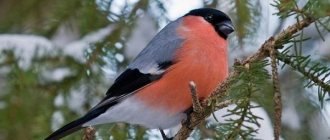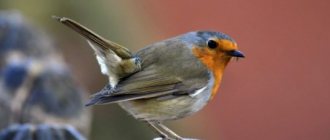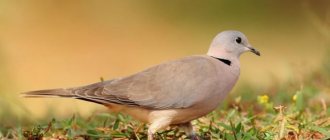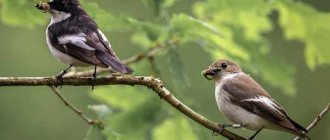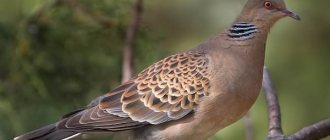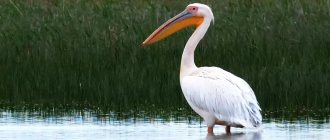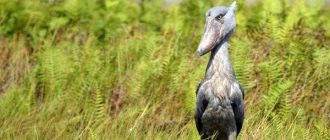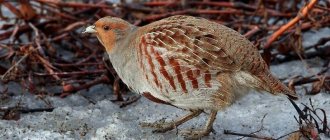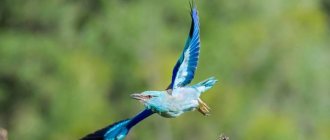- Wild animals
- >>
- Birds
The buzzard is not the largest bird of prey, but it is widespread. Very often they can be seen in Russia, especially in the European part of the country. By exterminating rodents, buzzards do not allow them to proliferate excessively, and if there are few of these animals around them, they switch to feeding on frogs, snakes, and other birds. Buzzards are very skilled hunters.
Origin of the species and description
Photo: Kanyuk
The common buzzard, also known as the buzzard, has been known to people since ancient times, and was scientifically described by Carl Linnaeus in 1758. It received the name Buteo buteo in Latin; in addition to this species, the genus of real buzzards includes three dozen others.
Buzzards belong to the order Accipitridae. According to the most common version, its first representatives appeared shortly after the Cretaceous-Paleogene extinction, when a large number of ecological niches were freed up, including for flying predators.
Video: Buzzard
The most ancient fossil representative of hawk-like birds, Masiliraptor, inhabited the planet 50 million years ago. From it and subsequent species that have not survived to this day, the current ones originated: the process of the formation of modern genera and widows dragged on for tens of millions of years.
As determined by genetic researchers, modern buzzards are a young genus. It separated from other accipitridae about 5 million years ago, but its species that lived on Earth at that time had already become extinct, and modern ones appeared only 300,000 years ago.
Interesting fact: Buzzards are smart and very careful: in order not to give away the location of their nest, they fly to it not directly, but in a roundabout way, and land on other trees along the way.
Habits and lifestyle of birds
The common buzzard appears lazy when it sits quietly and for a long time on a branch, but in fact it is an active bird that flies back and forth over fields and forests. Usually it lives alone, but during migration flocks of 20 individuals are formed; buzzards use rising currents of warm air to fly long distances without much effort.
Flying over large bodies of water where there are no thermal springs, such as the Strait of Gibraltar, birds rise as high as possible, then soar over this body of water. The buzzard is an extremely territorial species, and the birds will fight if another pair or single buzzards encroach on the pair's territory. Many smaller birds, such as crows and jackdaws, consider buzzards to be a threat and act as a flock to drive predators away from a particular area or tree.
Appearance and features
Photo: What a buzzard looks like
The length of the buzzard is 50-58 cm, and its wingspan is from 105 to 135 cm. There are three color options for the bird: brown with a red and variegated belly, brown with an ocher belly, and dark brown. Each of these color types can be traced from the buzzard's youth to its old age. The most common birds are the first type, the most rare are the third. Sometimes buzzards are confused with honey buzzards, which are very similar in color; they can also be confused with other species.
But there are a number of signs, if you find a few of which you can unmistakably recognize a buzzard:
- it has yellow legs, but it stands out much more by the color of its beak: at the very base it is yellow, then becomes pale blue, and darkens towards the end;
- The cornea of the eye of a young buzzard is brown with a reddish tint, gradually becoming more and more gray. Young individuals are generally more colorful; over time, the color becomes more uniform;
- a sitting buzzard can be distinguished from another bird by its posture: it seems to shrink all over, and most importantly, it draws up one leg. He is always ready to push off with it and take off in flight after prey: even when resting, he continues to look around the surroundings and look for something to profit from.
These are the main signs, but others are worth briefly noting: a flying buzzard presses its neck tightly to its body, its tail is clearly rounded and wide open, its wings are wide, with light spots on them; The bird does not hold its wings in line with the body, but raises them slightly upward; Most individuals have a clearly visible dark stripe running along the edge of the tail, but some do not have it.
Benefits for humans
An interesting fact that few people know about. It is believed that the verb “moan” appeared thanks to this particular bird, or rather its ability to make a nasal, drawn-out, whining sound, similar to the one that spoiled children sometimes make when begging for something they want.
This bird has always been considered magical and protected by man. Its appearance previously foreshadowed a good harvest, and for good reason. The bird eats rodents that destroy crops. They dig holes and passages between the roots and eat plants.
Birds also prevent orthopteran pests of fields and vegetable gardens from reproducing. These include:
- Grasshoppers;
- fillies;
- Locust.
These insects are also part of their diet. All gardeners and farmers know very well how difficult it is to exterminate them. Therefore, they never drive mousecatchers away from the plantings and even wait for their appearance.
Buzzards are also useful in nature. They are real orderlies, regulate the number of uncontrollably breeding rodents, and eat carrion.
Where does the buzzard live?
Photo: Buzzard in flight
They inhabit large areas including:
- almost all of Europe, including the European part of Russia - they are not found only in the north of Scandinavia;
- the south of the Asian part of Russia;
- Caucasus;
- Asia Minor;
- Near East;
- Iran;
- India;
- most of Africa.
Less often than in the listed territories, the buzzard can be found in the countries of the Far East - China, Korea, Japan. Most of these birds are sedentary, and only representatives of the vulpinus subspecies, that is, small or steppe buzzards, fly south in the fall. They live in Russia, Scandinavia and Eastern Europe, and fly to India and Africa for the winter.
Although some of them may go for the winter not so far, to the coastal zones near the Black and Caspian Sea: to those territories where it may be cold in winter, but there is no snow. The bird is moderately thermophilic and can successfully survive the relatively cold winters of Europe. In the European part of Russia, buzzards are distributed quite evenly; they live mainly in areas where forests alternate with meadows and fields, where it is convenient for them to hunt. They also love coniferous forests, especially those located in hilly areas.
In the Asian part of Russia and in the north of Kazakhstan, they have chosen the forest-steppe zone. They often choose places near water bodies for settlement; they can live on rocks, although they prefer trees. They love hilly terrain, but do not live in the highlands: the maximum altitude at which they settle does not exceed 2,000 m, usually within the range of 200 - 1,000 m.
Now you know where the buzzard bird lives. Let's see what she eats.
Lifestyle
The buzzard lives for quite a long time, in the wild for about 25 years, in a nursery for about 30. It prefers to hunt in open areas, hovers in the air waiting for prey, demonstrating almost complete immobility. Or he watches from an ambush located on a hill. Acute vision helps him see over long distances.
The predator grabs the victim so quickly that the victim does not have time to understand what is happening. But sometimes, carried away by the hunt, the buzzard gets lost and can crash into a tree or wall without noticing the obstacle.
If a buzzard migrates, it does so in the spring in April, and in the fall in early September. It all depends on the local climate. Nests are built in trees and raised high. For this purpose, branches and dry grass are used.
These birds nest in pairs, carefully protecting their home from strangers. They lay no more than 5 eggs, but this is rare. Mostly 3 or 4 pieces. The shell is cloudy white, sometimes with brown specks. They incubate them in turn, and the hatched offspring are also fed together until the babies learn to fly. Usually this takes about 40 days, sometimes more - 50.
During the season, the female can lay eggs twice, thus protecting herself from failed broods.
Mousers are very careful and cunning. Returning home for the night, they confuse their tracks, flying in circles and perching on different trees.
In this video, ornithologist Ilya Voronin will show how the buzzard bird behaves when it is nervous:
What does the buzzard eat?
Photo: Buzzard bird
The poultry menu is quite extensive, but it includes only animal food. This:
- mice and other rodents;
- amphibians;
- small lizards;
- snakes;
- worms;
- shellfish;
- small birds and chicks;
- eggs;
- insects.
The main food of the buzzard is rodents - mice and others, mainly small ones. It can be called a specialized predator, since all its hunting style is needed in order to most effectively catch rodents. But, if their numbers decrease and it becomes more difficult to find prey, then the bird has to switch to other species.
Often in such cases it begins to feed near reservoirs where there are many small amphibians; you can also find worms and mollusks - there is a lot of food for the buzzard there. Unlike fields and ponds, they do not hunt in the forest, which means there are few forest animals on their menu. Usually, when there are enough rodents in the field, the buzzard does not pose a threat to other birds, but if there are few rodents, it can begin to feed on them: it catches small birds, eats chicks and eggs. If a hungry buzzard sees a bird of prey smaller than itself flying with prey, it tries to take it away.
Buzzards are also dangerous for lizards and snakes, including poisonous ones. But such hunting is dangerous for them: although buzzards are more dexterous, there is a chance that the snake will be able to bite the bird. Then she dies from the poison, because she has no immunity to it. Although buzzards prefer to hunt, if there is little prey, they can also eat carrion. This bird has a high appetite: one individual can eat three dozen rodents in a day, and in a year it destroys thousands of them. Thanks to this, they are very useful, because they kill a large number of pests such as mice, moles, and poisonous snakes. Young buzzards also destroy harmful insects.
Interesting fact: Buzzard is another name for buzzards, also used very often. Most likely it arose from the Turkic word “sary”, translated as “yellow”.
Distribution of buzzards in regions
This species is found in Europe and Russia, parts of North Africa and Asia during the cold winter months. Buzzards live:
- in forests;
- on the moors;
- pastures;
- among the bushes;
- arable lands;
- swamps;
- villages,
- sometimes in cities.
Features of character and lifestyle
Photo: Buzzard in Russia
The buzzard has well-developed sensory organs: it has very sharp vision, a good sense of smell and keen hearing. All this allows him to hunt effectively, and it is very difficult to get away from him. In addition, buzzards are also smart birds, this is especially noticeable when they find themselves in captivity - they can surprise people with their intelligence and cunning. Buzzards usually fly quite slowly, but they do it very quietly and are able to get close to the prey undetected. They rely mainly on surprise and a sharp throw. They can fly quite quickly, but are inferior to many other birds, including larger ones.
Their wings are much better suited for slowly floating in the air - they make almost no effort to do this. They can fly like this for many hours in a row and constantly inspect the ground below, and when the buzzard sees a potential victim, it falls to the ground like a stone, folding its wings, and spreads them only when it is already near the ground.
At the exit from this dive it develops a high speed, and most importantly, it turns out to be unexpected, which gives the bird the opportunity to reach the prey with its claws before it understands what is happening. Although the buzzard usually displays great dexterity when hunting, sometimes it gets too carried away, does not notice obstacles and crashes into them. Buzzards can also sit for a long time on a tree, most often choosing a dry one or one without branches on one side for a better view, or on a pole, and wait for prey. This is how they spend most of their day, and rest in the dark.
Migrating individuals move south in large flocks from the last days of summer until the end of September, depending on the area, and usually all of them fly away at once, so that on one day there are a lot of them flying around the area, and on another it immediately becomes empty. They return in mid-spring, and fewer birds fly back: young ones often remain in wintering areas for several years. Buzzards live quite a long time: 22-27 years, and in captivity up to 35.
Buzzard feeding features
Basically, buzzards feed on mice and rats, which are their favorite delicacy, as well as hamsters, moles, toads, and hares. Among the birds, the buzzard preys on partridges, pheasants, larks, and blackbirds. Can attack snakes. The advantage of a predator is that it exterminates vipers. But the bird is not protected from the venom of these snakes. And if a snake bites her, she dies. But this rarely happens.
The buzzard is easily recognized by the way it sits on rocks or tree branches. Usually the bird will bend one leg and cower. Thus, the buzzard simultaneously rests and looks out for prey. The bird flies slowly, but quietly and easily. It can float in the air for a long time. Seeing the prey, the buzzard sharply rushes down, pressing its wings tightly to its body. He spreads them only over the ground, then, after flying a short distance, he grabs the prey.
Social structure and reproduction
Photo: Common buzzard
Immediately after arrival, mating season begins. Males try to show themselves off with mating flights and start fights. When a pair is identified, it builds a nest or takes an old one and simply builds on it. Sometimes these nests originally belonged to other birds, most often crows. They prefer to build nests not in the depths of the forest, but near its edge; the tree can be either coniferous or deciduous. The nest is located in a fork of strong thick branches at a height of 7-15 meters. Buzzards try to make it equally difficult to spot both from the ground and from above. Very rarely the nest may be located on a rock.
The diameter of the nest is 50-75 cm, its height is small - 20-40 cm. The material for it is branches braided with dry grass - they are thick at the edge, and the closer to the center, the thinner. In the very middle there is a recess for the chicks made of very thin twigs, but insulated with various materials: feathers, moss, down, bark. If before laying one of the partners in a pair dies, then it is certainly replaced by another bird: after the pairs are identified, there are still a few single individuals of both sexes left. The clutch is laid until the end of spring, it usually contains 3-5 eggs. Their shell is grayish with a slight green tint, and has red or brown spots on it.
The average number of eggs in a clutch depends on the year: if the weather conditions are good and there are a lot of mice in the area, there will be more of them on average. In lean years, there may be only one egg in a clutch, and in the worst years, most buzzards will not have offspring at all. Incubation is primarily done by the female; this period lasts up to 5 weeks. At this time, the male is also not idle, but feeds the female so that she can not fly away from the nest. The bird on the clutch is not aggressive, it tries to hide when strangers appear nearby or emits alarming cries while flying around.
If she is often disturbed during hatching, she may leave the clutch and make a second one - usually there is only one egg in it. When the chicks hatch, they are covered with rather dark brownish down. At first the male is in charge of getting food for them, and the female distributes it, so that everyone gets their share. When the chicks change their brown fluff to gray, both parents begin to get food - too much of it becomes needed. then they simply begin to throw food into the nest, and the chicks share it themselves and often begin to fight with each other.
The more abundant the year, the more chicks survive. If it turns out to be poorly fed, then most likely 1-2 individuals will survive to flight. Young buzzards learn to fly at 6-7 weeks of life, and when they master flight well, they leave their parents and begin to hunt on their own - usually this happens by the end of July. Late chicks can fly out until the first half of September; most often they come from the second clutch. Birds from the same brood continue to stay together during the time remaining before flying south, and migrate until mid-autumn. Some buzzards linger until November and may even remain through the winter.
Bird mating rituals
Common buzzards are monogamous and pairs mate for life. The male attracts a mate (or impresses his mate) by performing an exciting ritual dance in the air called a roller coaster. The bird flies high in the sky, then turns and descends, twisting and turning in a spiral, only to rise again immediately and repeat the mating ritual.
From March to May, the breeding pair builds a nest in a large tree on a branch or fork, usually near the edge of the forest. The nest is a bulky platform of sticks covered in greenery where the female lays two to four eggs. Incubation lasts from 33 to 38 days, and when the chicks hatch, their mother cares for the offspring for three weeks and the male brings food. Fledging occurs when the young are 50 to 60 days old, and are nursed by both parents for another six to eight weeks. At three years old, common buzzards become reproductively mature.
Natural enemies of buzzards
Photo: Buzzard in winter
Catching a buzzard is a very difficult task because of its keen vision and hearing, and therefore even larger birds of prey do not hunt it. But he cannot feel completely safe either: a gaping buzzard with prey can be attacked by eagles, gyrfalcons, falcons - and everyone tries to take it away.
These birds are larger and stronger, so a buzzard can receive serious wounds in a fight with them. But this happens infrequently; the likelihood of a conflict with another buzzard is much greater. They mainly occur during the mating season, but at other times they are also possible due to the territory - there is not always enough for everyone, and disadvantaged birds are forced to hunt in foreign lands.
In such fights, one or even both birds can suffer greatly from the sharp claws and beaks. The loser will be expelled, and the winner will take or continue to own the territory. The losing bird does not have the opportunity to hunt and may die from wounds and hunger - after all, in order for the wounds to heal, it needs to eat more.
Nest destroyers cause even more damage to buzzards: large birds like hawks and kites, as well as smaller ones like crows and magpies, can do this; Martens and weasels also love to feast on eggs and chicks. But buzzards do not suffer as much damage from them as many other birds, since the female leaves the nest very rarely.
Among the enemies of the buzzard are humans: for example, in the USSR they were considered pests and a reward was given for their extermination, so they were killed in the thousands every year. In other countries, this was also practiced, and in some places they are still being killed uncontrollably.
But more birds have been suffering in recent years due to the chemical industry and the treatment of land with poisons - for example, to kill insects. The accumulation of such poisons in the body of buzzards leads to their earlier death.
Threats to the species
The common buzzard is not currently globally threatened. The bird population was greatly affected by the decline in the number of rabbits, one of the main food sources, in the 1950s due to myxomatosis (a disease caused by the myxoma virus that affects lagomorphs).
Number of buzzards
The total number of buzzards is about 2–4 million mature individuals. About 800 thousand–1,400,000 pairs or 1,600,000–2,800,000 mature individuals breed in Europe. Overall, common buzzards are currently classified as not at risk and their numbers remain stable. As predators, buzzards influence the abundance of prey species.
How is the buzzard useful?
The common buzzard is a useful bird. In one day, she eats up to 35 small rodents. If we translate this value into more serious numbers, we get about 11,000 rodents per year. Without any doubt, the feathered robber thus provides great benefits to the environment and agriculture, since it destroys harmful animals. By the way, if there are quite a lot of mice, then the buzzards generally stop paying attention to other living creatures. What a useful assistant he is - this buzzard!
The bird (pictures presented in the article) is popular among ornithologists and hobbyists not only as a rodent exterminator, but also as a viper killer! Unfortunately, nature did not reward these birds with immunity from viper venom. Therefore, sometimes the snake and the buzzard destroy each other.
Nevertheless, in most cases, the feathered robber still emerges victorious from this mortal battle. Ornithologists say that such courage and intelligence is inherent in all representatives of the buzzard genus. In captivity, these birds display sophisticated cunning.
Red-tailed hawk, or red-tailed buzzard
Red-tailed hawk or red-tailed buzzard (Buteo jamaicensis)
Class – Birds
Squad – Birds of Prey
Family – Accipitridae
Rod – True Buzzards
Appearance
The red-tailed buzzard is from 45 to 58 cm long, the wingspan is from 107 to 141 cm. Females are noticeably larger than males, that is, we can talk about sexual dimorphism. Males weigh from 700 g to 1.3 kg. The weight of females varies from 900 g to 2 kg. The smallest birds live in the region of Puerto Rico, and the largest ones have chosen the state of Wisconsin. The wings are wide, rounded, the beak is much stronger than that of the buzzard. The color of the plumage depends on the subspecies and region of habitat. It can be light, dark and in between. Common features are a whitish underbelly with a dark brown stripe on the belly. The chest is covered with dark brown spots. The tail is brick red in color with orange feathers at the end. The beak is short and dark. Its shape is hooked. The limbs of all subspecies are yellow.
Habitat
The red-tailed buzzard is widespread in North and Central America. Prefers forests bordering open landscapes, prairies with woody plants, and deserts.
In nature
In flight, this bird of prey soars, rarely flapping its wings. In this case, the speed can be 32-60 km/h. Having seen prey, the predator falls on it at a speed of up to 190 km/h. Makes hoarse, squeaky screams. The diet consists of small mammals, as well as birds and reptiles. Rodents make up 85% of the diet. These are mice, gophers, voles, chipmunks, and squirrels. Additional prey includes shrews, bats, pigeons, quails, fish, crustaceans, insects, and worms. Snakes and lizards are also eaten. In addition, red-tailed buzzards have been observed attacking domestic cats and dogs. Hunting is carried out in two ways. The bird either sits on a hill, looking for prey, or soars high in the air. The predator may also chase its prey on the ground. Sometimes these birds hunt in pairs.
Reproduction
Sexual maturity in these birds occurs at the age of 2 years. Males and females form monogamous pairs for many years. A change of partner occurs only in the event of the death of one of the birds. Nests are built in large trees at heights of 4 to 20 meters from the ground or on rock ledges. The nest is made from branches, and its diameter can reach 90 cm. There are from 1 to 3 eggs in the clutch. They are laid in March-April depending on latitude. The female does the incubation and the male carries the food. The incubation period lasts 28-35 days. The chicks begin to fly at the age of 42-46 days, and become completely independent of their parents at the 4th month of life. Young birds begin to breed mainly at 3 years of age.
In the wild, the red-tailed buzzard lives for 25 years. The maximum life expectancy is 29-30 years.
Captivity
The approximate parameters of the cage should be at least 100x100x150 cm. It is recommended to place one perch inside the cage as a perch. The diameter of the perch should be such that the bird’s claws dig into the perch, and do not hang down, grasping it. A bird sitting on a perch should be able to flap its wings freely without touching the floor and walls of the cage. A small stump (chock) is placed in the center of the cage; this will be a table. You need to install the perches and stretch a plastic mat (artificial grass) over them. It is also recommended to lay a rug on the stump. This is necessary to prevent pododermatitis (naminitis) from occurring in birds. It is recommended to place the cage in a well-lit place, at the level of your chest, neither higher nor lower. There should always be fresh water in the cage, as the bird can bathe in it. If the bird is not kept at home, it is recommended to build an aviary; its dimensions should be much larger than the size of the home cage, approximately three to four times. The perches should be the same as in the cage. So that the bird can withstand bad weather in the enclosure, the walls forming the corner are made solid, the roof must be completely closed. The other sides are covered with lattice or mesh. It is necessary to organize treatment for helminths 2 times a year and to conduct an examination with an ornithologist once a year.
At home, birds should be fed food that is as natural as possible. If a predator in the wild ate birds, they can be replaced with chickens and quails.
They can be freely purchased at the market and specialized pet stores. Predators can be fed with low-fat meat (chicken necks, heads, beef tenderloin without veins and fat), but this is not enough, since this meat does not contain the required composition of vitamins, minerals and microelements that the whole carcass of the food item contains.
Birds of prey should not be fed animals caught in the wild: field mice, and other rodents or birds: sparrows, tits, pigeons, jackdaws. With such feeding, there is a high risk of contracting a helminthic infestation, since most helminths use birds as an intermediate host. Helminths can penetrate all tissues and organs.
When feeding, you should try to feed the birds whole carcasses along with feathers, wool, and bones. This is very important because in the bird’s gastrointestinal tract, pellets are formed from indigestible food debris; this is necessary for the normal functioning of the bird’s digestion. Normally, when feeding, the predator secretes a pellet from undigested wool and bones. This is a normal physiological component for a bird of prey. Do not forget that a predator must be fed with the carcasses of animals and birds, and very rarely, only as a last resort, with meat and nothing else. Adult birds are given food once a day, chicks 3-6 times a day, the number of feedings depends on age. Adult predators need to go on a fasting day once every seven days, but there must be fresh water. Be sure to feed half the diet once a week, and do not forget about fresh water. This is useful and will be a good preventive measure against bird obesity; physiologically it is similar to the natural habitat of a predator in nature. In the wild, a predator cannot always catch prey normally. Therefore, he does not always have food in his diet.
As a rule, birds of prey do not drink in good and moderate weather. And during the heat, they drink a lot of water and love to swim.
There are the following feeding norms: for a hawk, the norm of food per day is 2-3 mice or chicken, or one quail.
When feeding a sick bird, food should be served with a wooden stick approximately 10 cm long. When force-feeding hawks, the meat should be placed on the tip of the stick and pressed firmly against the bird's beak. The bird will open its beak, and you need to carefully push the meat into the beak and turn the stick. The meat that gets into the beak can be slightly pushed, thereby provoking a swallowing reflex in the bird. This is done carefully so as not to scratch the back wall of the pharyngeal mucosa. In this process, you cannot use metal objects; you can injure the bird’s beak.
If the bird is in good condition, food should be placed on a clean board or stump and the bird should be allowed to eat on its own. If the bird is injured, food should be placed behind it on the perch.
A very important factor in keeping such a bird at home is normal nutrition; the use of beef or poultry as food does not create conditions for normal feeding for your pet. If we consider the physiological needs, then for the proper functioning of the digestive system of birds of prey, components such as wool, feathers, and small bones are important. These “by-products” are indigestible components in the bird’s stomach; dense lumps are formed from them - “pellets”. Under good conditions, the bird regurgitates pellets as they occur. In the absence of normal nutrition, if the predator does not form pellets (i.e., the food is completely digested), the regurgitation mechanism is disrupted. This subsequently affects peristalsis (contraction) of the entire intestinal tract. Loss of pellets can lead to impaired absorption of vitamins and minerals from the intestinal lumen. For predators, the absorption of calcium and magnesium plays a special role; if they are deficient, this leads to a general systemic disease in the bird.
You need to know one of the main aspects for finding birds of prey at home, this is due to the fact that the droppings spread in the form of a stream and cover a distance of up to two, three meters. Prepare for the fact that the room where you keep the bird will be spoiled, in addition to the bad smell from the remains of parts of the feed.
They are well tamed for hunting. You can buy ammunition on our website.
